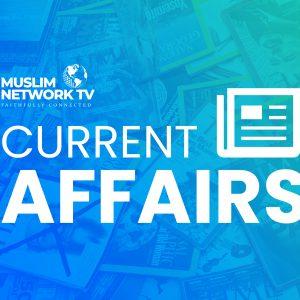‘Scholasticide’: How Israel is systematically destroying Palestinian education in Gaza
ISTANBUL (AA) – In the south of Gaza, a white, blue and sand-colored structure with lush green lawns once stood tall.
Every day, hundreds of Palestinians would make their way to Israa University, a building with an imposing facade inspired by Islamic architecture.
Today, though, the university exists only in memories and visual archives.
A widely circulated video captures the exact moment when the university was blown to rubble by Israeli forces, leaving behind clouds of dust and a scene of utter devastation.
In a conversation with the media, Palestinian historian Abdel Razzaq Takriti’s emotions are visible when he speaks about the destruction wreaked by Israel.
His eyes well up with tears and his voice becomes shaky.
“I cried when I saw the destruction of this university. It was premeditated … They knew exactly what they were doing,” he said.
Takriti and his colleagues from around the world are part of a group called Scholars Against the War on Palestine (SAWP), which aims to raise awareness about and stop the ongoing “scholasticide,” the term they use for Israel’s deliberate destruction of Palestinian education.
Takriti, an associate professor of history and Arab-American Educational Foundation Chair in Arab Studies at Rice University in the US, calls the destruction a “total annihilation of Palestinian education.”
– Systematic destruction of education –
According to SAWP findings, Israel has bombed all of the enclave’s 11 universities since Oct. 7, 2023: Islamic University of Gaza, Al-Azhar University, Al-Quds Open University, University College of Applied Sciences, University of Palestine, Israa University, University of Gaza, Al-Aqsa University, Palestine Technical College, Palestine College of Nursing, and Arab College of Applied Sciences.
That has rendered some 90,000 Palestinian students unable to continue their university education.
Around 370 schools have been damaged or destroyed, leaving more than 620,000 students out of schools.
Israeli attacks have also killed 231 educators and academics, with at least another 707 injured, SAWP data shows.
The number of students killed is at least 4,237 and more than 7,800 have been wounded.
Eight dedicated libraries and four university libraries have also been damaged or destroyed.
All of this, the group says, fits the description of scholasticide, first coined by a Palestinian professor at Oxford University, Karma Nabulsi, an expert on the laws of war.
The term combines the Latin prefix ‘schola,’ which means school, and the Latin suffix ‘cide,’ which means killing.
“She (Nabulsi) conceptualized it in the context of the Israeli assault on Gaza in 2009, but also with reference to a pattern of Israeli colonial attacks on Palestinian scholars, students and educational institutions,” explains Takriti.
The assault goes back to the founding of the state of Israel in 1948, with the pattern expanding after the 1967 war in Palestine, and “manifesting in new forms after the Israeli invasion of Lebanon in 1982, which witnessed the sacking and the destruction of important Palestinian cultural and educational material,” he said.
According to Takriti, Nabulsi found that Israel’s systematic destruction of Palestinian education was “to counter a tradition of learning in Palestine.”
Takriti believes that scholasticide is very “intimately connected to genocide,” something that the International Court of Justice (ICJ) said Israel could plausibly be committing in Gaza.
Following the Israeli ground invasion of Gaza, the professor and other scholars launched SAWP, which he described as “a transnational coalition from universities primarily in the United States, Canada, the UK and South Africa, but also across Europe and in many parts of the Middle East and Latin America.”
In December, the coalition launched a petition demanding a cease-fire in Gaza, which was signed by 1,000 leading scholars from across the globe.
Scholasticide also includes killing of teachers, students and staff, as well as arrests and detention of people involved with educational institutions. Its other factors include bullying and intimidation of teachers and students, bombarding and demolishing of educational institutions, the destruction of resources like libraries, archives and laboratories.
The SAWP also monitors the besieging of educational institutes by Israeli forces and their use as barracks, logistics bases or even detention and interrogation centers.
– Silence of Israeli academics –
Takriti lambasted Israeli professors and scholars for their silence over attacks on Gaza’s education sector.
Some of these Israeli academics are even reservists in the Israeli army, as are many Israeli students, he said.
“Can we conceptualize that it’s colleagues killing colleagues, it’s fellow students killing other students just because they happen to be Palestinian? It’s cruel,” he asserted.
Dead bodies of Palestinians are kept at the University of Tel Aviv, for example, and there are other institutions that offer similar services to the Israeli military, he said.
They also house looted Palestinian archives and cultural materials, he said.
“They stand silent when all these crimes are committed against their colleagues in Palestine. In some cases, in many cases, even most cases, they are actually promoting them,” he added.
“They’re all standing united with their state instead of actually doing the right thing and saying a word about this horror that is taking place.”
– Looking ahead –
The professor emphasized that rebuilding Palestinian education infrastructure will be a shared responsibility for all.
“We have a responsibility. We need to strengthen the UN provision of education, not weaken it. We need to strengthen local Palestinian provision of education and rebuild it because it’s been completely destroyed,” said Takriti.
He stressed that there would be a need for enormous volunteer efforts from across the world, as well as investment from governments and NGOs.
Takriti is proud of the stand taken by his colleagues in the academic community, but he knows well that much more needs to be done.
“It’s not enough,” he said.










